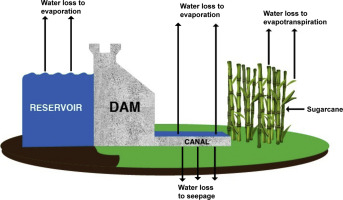当前位置:
X-MOL 学术
›
Sci. Total Environ.
›
论文详情
Our official English website, www.x-mol.net, welcomes your feedback! (Note: you will need to create a separate account there.)
Incorporating water loss from water storage and conveyance into blue water footprint of irrigated sugarcane: A case study of Savannah Sugar Irrigation District, Nigeria.
Science of the Total Environment ( IF 9.8 ) Pub Date : 2020-01-22 , DOI: 10.1016/j.scitotenv.2020.136886 Taitiya Kenneth Yuguda 1 , Yi Li 1 , Wenlong Zhang 1 , Quanliang Ye 2
Science of the Total Environment ( IF 9.8 ) Pub Date : 2020-01-22 , DOI: 10.1016/j.scitotenv.2020.136886 Taitiya Kenneth Yuguda 1 , Yi Li 1 , Wenlong Zhang 1 , Quanliang Ye 2
Affiliation

|
Assessing the impacts of irrigation on water resources is crucial to effectively understanding how water is withdrawn for irrigation purposes. Consequently, the extraction of water from rivers, reservoirs and aquifers for irrigation purposes usually exceeds the net requirement for irrigation due to water lost in its delivery from source to the crop fields. In this this study, we have proposed a model for incorporating seasonal water loss from storage reservoir and conveyance canal into the crop water footprint of irrigated sugarcane. By taking into consideration the duration of seasonal irrigation water release for sugarcane production, we present a method for allocation of blue water footprint using savannah sugar irrigation district as case study. Results have shown that significant volume of water is evaporated seasonally due to irrigation of sugarcane, despite the introduction of an allocation factor to account of evaporation loss to irrigation. For the study period of 2007-2017, the reservoir is the main contributor to water loss by evaporation, it accounts for an average seasonal water loss of 1.1 × 108 m3, followed by evapotranspiration from the crop field 0.26 × 108 m3 and then seepage and evaporation losses from the canal 7.9 × 104 m3. The average seasonal blue water footprint of sugarcane for the period considered is 877 m3/ton which exceeds the global average 209 m3/ton. Plans to expand hectares of cultivated land by the company to boost sugarcane productivity, coupled with the ongoing effort to incorporate hydroelectric power plant to the existing dam to augment electric power supply in the district, will greatly influence the availability water resources in the region. This study highlighted the need for a comprehensive evaluation of water use in irrigated agriculture and may serve as an indicator for optimizing future objectives and strategies associated with water resource planning globally.
中文翻译:

将储水和输水造成的失水纳入灌溉甘蔗的蓝色足迹中:以尼日利亚萨凡纳糖灌区为例。
评估灌溉对水资源的影响对于有效了解如何将水用于灌溉目的至关重要。因此,从河流,水库和蓄水层中抽取的用于灌溉目的的水通常会超过灌溉的净需求,这是因为从源头到农田的输水会造成损失。在这项研究中,我们提出了一个模型,用于将储水库和输水渠道的季节性失水纳入灌溉甘蔗的作物水足迹中。考虑到甘蔗生产中季节性灌溉水释放的持续时间,我们提出了一种使用大草原食糖灌溉区作为案例研究的蓝色水足迹分配方法。结果表明,尽管引入了分配因子以解决灌溉蒸发损失,但由于甘蔗灌溉,季节性蒸发了大量水。在2007年至2017年的研究期间,水库是蒸发失水的主要因素,其平均季节性失水量为1.1×108 m3,其次是农田的蒸散量为0.26×108 m3,然后渗水和渠道的蒸发损失为7.9×104立方米。在此期间,甘蔗的平均季节性蓝色海水足迹为877立方米/吨,超过了全球平均水平209立方米/吨。公司计划扩大耕地面积,以提高甘蔗生产力,再加上正在进行的将水力发电厂合并到现有大坝中以增加该地区电力供应的努力,将极大地影响该地区的可用水资源。这项研究强调了对灌溉农业用水的全面评估的必要性,并且可以作为优化与全球水资源规划相关的未来目标和战略的指标。
更新日期:2020-01-22
中文翻译:

将储水和输水造成的失水纳入灌溉甘蔗的蓝色足迹中:以尼日利亚萨凡纳糖灌区为例。
评估灌溉对水资源的影响对于有效了解如何将水用于灌溉目的至关重要。因此,从河流,水库和蓄水层中抽取的用于灌溉目的的水通常会超过灌溉的净需求,这是因为从源头到农田的输水会造成损失。在这项研究中,我们提出了一个模型,用于将储水库和输水渠道的季节性失水纳入灌溉甘蔗的作物水足迹中。考虑到甘蔗生产中季节性灌溉水释放的持续时间,我们提出了一种使用大草原食糖灌溉区作为案例研究的蓝色水足迹分配方法。结果表明,尽管引入了分配因子以解决灌溉蒸发损失,但由于甘蔗灌溉,季节性蒸发了大量水。在2007年至2017年的研究期间,水库是蒸发失水的主要因素,其平均季节性失水量为1.1×108 m3,其次是农田的蒸散量为0.26×108 m3,然后渗水和渠道的蒸发损失为7.9×104立方米。在此期间,甘蔗的平均季节性蓝色海水足迹为877立方米/吨,超过了全球平均水平209立方米/吨。公司计划扩大耕地面积,以提高甘蔗生产力,再加上正在进行的将水力发电厂合并到现有大坝中以增加该地区电力供应的努力,将极大地影响该地区的可用水资源。这项研究强调了对灌溉农业用水的全面评估的必要性,并且可以作为优化与全球水资源规划相关的未来目标和战略的指标。

























 京公网安备 11010802027423号
京公网安备 11010802027423号